Metalcore has evolved significantly since its inception, blending hardcore punk and heavy metal to create a dynamic sound. Key influences include aggressive rhythms and melodic elements, with essential tracks highlighting its defining characteristics. The genre features distinct subgenres that cater to diverse tastes, while current trends showcase innovative sounds and collaborations. Artists face challenges like genre saturation and audience engagement in a rapidly changing musical landscape.
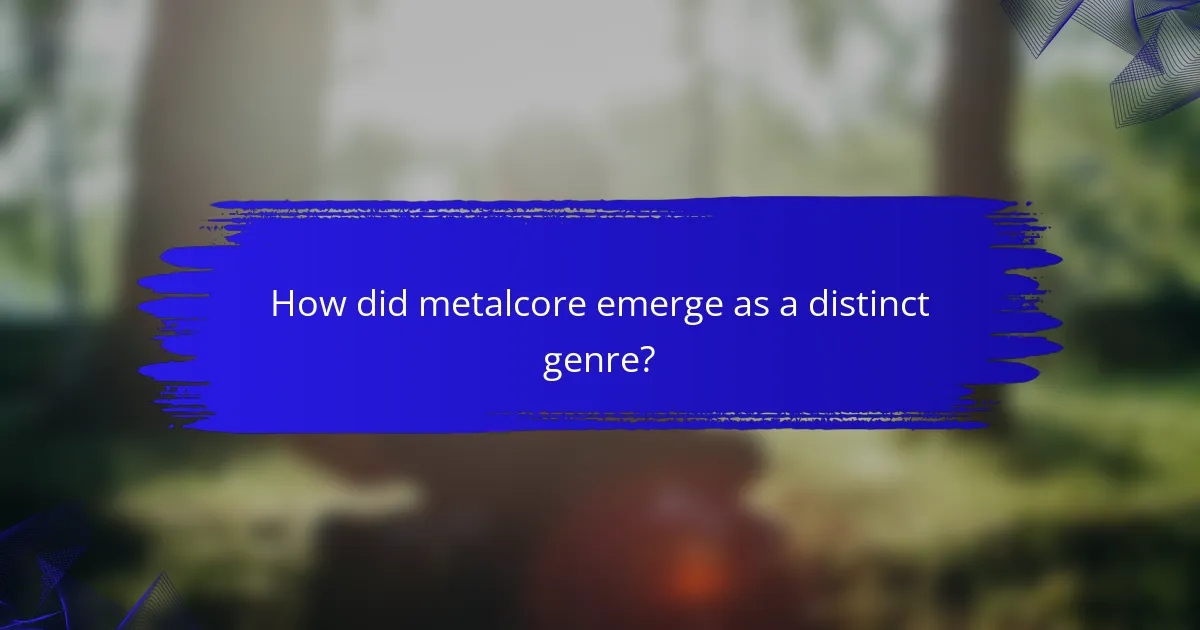
How did metalcore emerge as a distinct genre?
Metalcore emerged as a distinct genre in the late 1980s and early 1990s, blending elements of hardcore punk and heavy metal. Influences include bands like Earth Crisis and Converge, which introduced aggressive guitar riffs and breakdowns. Essential tracks that shaped the genre include “Heartwork” by Carcass and “The End of Heartache” by Killswitch Engage. The genre’s evolution continued with diverse substyles, incorporating melodic elements and varying vocal techniques, appealing to a broad audience.
What are the key characteristics that define metalcore?
Metalcore is defined by its fusion of heavy metal and hardcore punk elements, characterized by aggressive guitar riffs, breakdowns, and intense vocal styles. Key characteristics include a blend of melodic and harsh vocals, complex guitar work, and a focus on emotional themes. The genre often features breakdowns that create rhythmic intensity, making it distinct within the metal scene. Influences from various genres, including thrash metal and post-hardcore, contribute to its evolving sound. Essential tracks often exemplify these traits, showcasing the balance between melody and aggression.
Which bands were pivotal in shaping the early metalcore sound?
Bands pivotal in shaping the early metalcore sound include Earth Crisis, Hatebreed, and Converge. Earth Crisis introduced a blend of hardcore punk and metal, emphasizing themes of social activism. Hatebreed’s aggressive style and anthemic choruses helped popularize the genre. Converge’s complex song structures and emotional intensity set a unique standard within metalcore. These bands collectively influenced the genre’s evolution, impacting countless artists and shaping its identity.
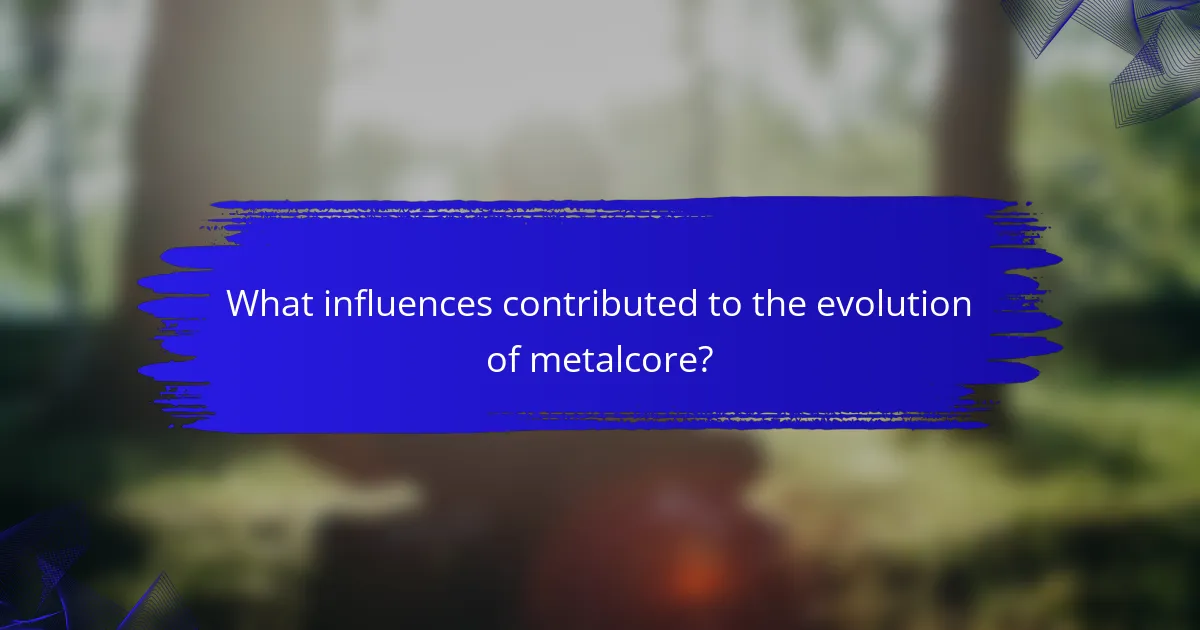
What influences contributed to the evolution of metalcore?
Metalcore evolved through a blend of hardcore punk, heavy metal, and various subgenres. Key influences include the aggressive rhythms of punk, melodic elements from metal, and the emotional intensity of post-hardcore. Essential tracks that shaped the genre include “My Curse” by Killswitch Engage and “The End of Heartache” by the same band, showcasing its defining characteristics. The genre’s growth reflects a unique attribute of combining diverse musical styles, appealing to a broad audience.
How did hardcore punk impact the development of metalcore?
Hardcore punk significantly influenced the development of metalcore by introducing its aggressive sound and DIY ethos. The fusion of hardcore’s intensity with metal’s complexity created a new genre characterized by heavy guitar riffs and breakdowns. Bands like Converge and Earth Crisis exemplified this blend, incorporating punk’s raw energy and metal’s technical prowess. The lyrical themes often mirrored hardcore’s social and political commentary, enhancing the genre’s emotional depth. As a result, metalcore emerged as a distinct style, rooted in hardcore punk’s foundational elements while expanding into a broader musical landscape.
What role did metal bands play in the formation of metalcore?
Metal bands significantly influenced the formation of metalcore by blending elements of hardcore punk and heavy metal. Bands like Earth Crisis and Converge introduced aggressive riffs and breakdowns, shaping the genre’s sound. Their emphasis on emotional intensity and social themes resonated with fans, establishing a foundation for metalcore’s evolution. The incorporation of melodic elements by bands such as Killswitch Engage and As I Lay Dying further diversified the genre, creating a unique identity. This fusion of styles and themes contributed to metalcore’s rise in popularity during the late 1990s and early 2000s, making it a prominent subgenre in the metal scene.
Which cultural movements influenced metalcore’s lyrical themes?
Metalcore’s lyrical themes are influenced by various cultural movements, including punk, hardcore, and emo. These genres emphasize personal struggle, social issues, and emotional expression. Punk’s rebellious spirit is evident in metalcore’s critique of societal norms. Hardcore’s intensity contributes to themes of resilience and defiance. Emo’s focus on vulnerability shapes the exploration of emotional pain and relationships. These influences create a rich tapestry of lyrical content, reflecting both personal and collective experiences.
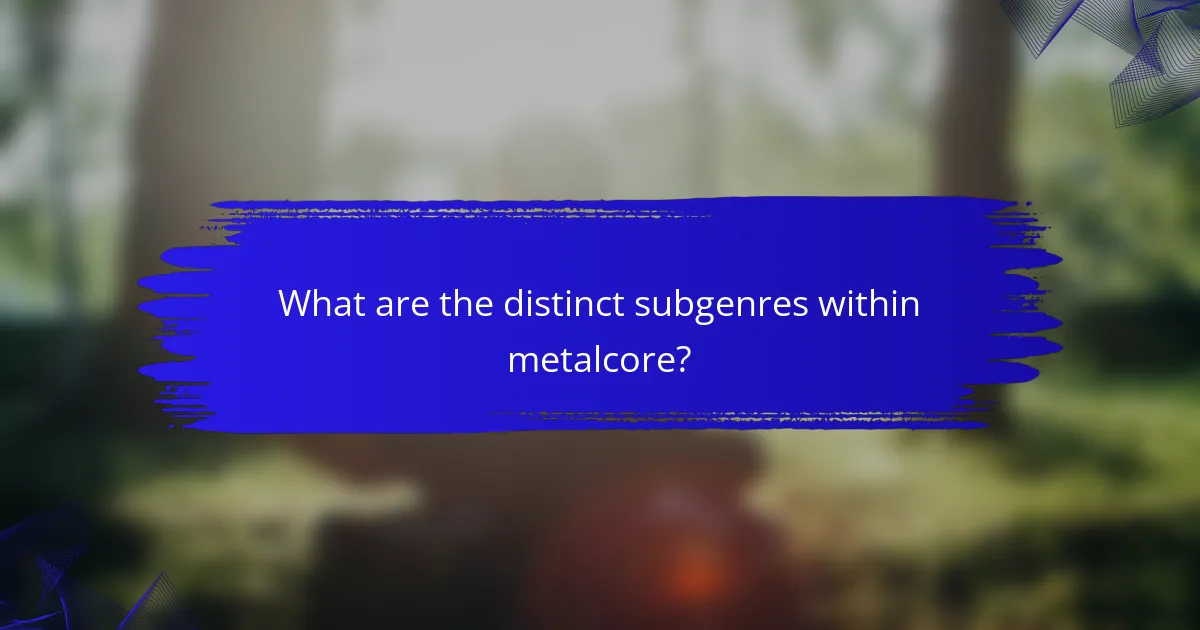
What are the distinct subgenres within metalcore?
Metalcore features several distinct subgenres, each with unique characteristics. Prominent subgenres include melodic metalcore, characterized by harmonized guitar melodies; hardcore metalcore, known for its aggressive breakdowns and vocals; and post-metalcore, which incorporates atmospheric elements. Other notable subgenres are djent metalcore, which emphasizes complex time signatures, and symphonic metalcore, blending orchestral arrangements with heavy riffs. Each subgenre contributes to the evolution of metalcore, reflecting diverse musical influences and fan preferences.
How does melodic metalcore differ from traditional metalcore?
Melodic metalcore incorporates melodic elements and harmonies, while traditional metalcore focuses on heavier riffs and aggressive vocals. This evolution reflects a blend of genres, enhancing emotional depth and musical complexity. Key influences include post-hardcore and melodic death metal, differentiating their sound. Essential tracks often showcase these melodic features, highlighting the genre’s growth.
What defines post-metalcore, and which bands exemplify this style?
Post-metalcore is defined by its blend of metalcore’s aggression with post-rock’s atmospheric elements. Bands like The Devil Wears Prada and Architects exemplify this style through their intricate compositions and emotional depth. The genre often features melodic riffs, heavy breakdowns, and introspective lyrics, showcasing a unique fusion of influences. Essential tracks include “Sail” by AWOLNATION and “Doomsday” by Architects, which highlight the genre’s signature sound and thematic exploration.
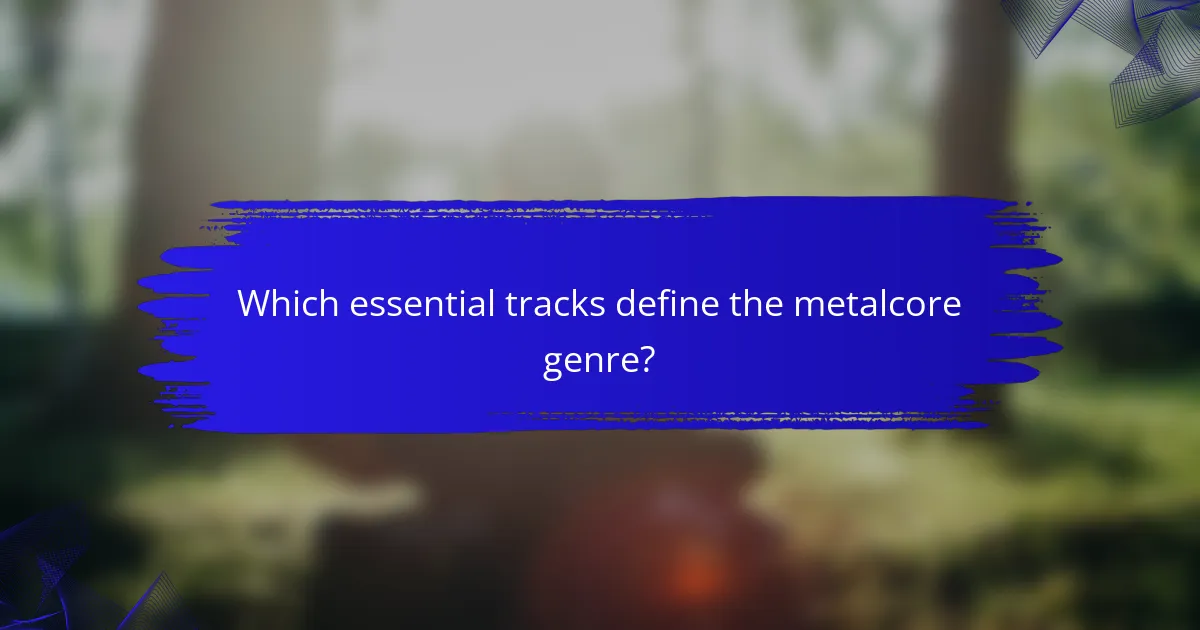
Which essential tracks define the metalcore genre?
Essential tracks that define the metalcore genre include “My Curse” by Killswitch Engage, “The End of Heartache” by Killswitch Engage, “Prayer of the Refugee” by Rise Against, “Heartless” by The Devil Wears Prada, “This Calling” by All That Remains, and “In Due Time” by Killswitch Engage. These tracks showcase the genre’s signature blend of heavy riffs, melodic elements, and emotional lyrics. Each track highlights unique attributes of metalcore, such as dynamic shifts and powerful vocal delivery.
What are the must-listen albums for any metalcore fan?
Metalcore fans should listen to “The End of Heartache” by Killswitch Engage, “Silent Circus” by Between the Buried and Me, “Earthbound” by The Devil Wears Prada, “Homesick” by A Day to Remember, “Dirt” by Poison the Well, and “We Are the Ocean” by We Are the Ocean. These albums showcase the evolution and influences of metalcore, featuring essential tracks that define the genre. Each album presents unique attributes, such as Killswitch Engage’s melodic metalcore sound and The Devil Wears Prada’s experimental approach.
How have iconic metalcore songs influenced newer bands?
Iconic metalcore songs have significantly influenced newer bands by shaping their sound and lyrical themes. The blend of heavy riffs and melodic elements established a framework that many contemporary bands adopt. For example, the emotional intensity and technical precision of early metalcore acts like Killswitch Engage and Underoath serve as benchmarks for newer artists.
Additionally, the incorporation of diverse influences, such as post-hardcore and punk, has encouraged newer bands to experiment with their musical styles. This evolution reflects a unique attribute of metalcore, where bands continuously push creative boundaries. As a result, the genre remains dynamic, with fresh sounds emerging while honoring its roots.
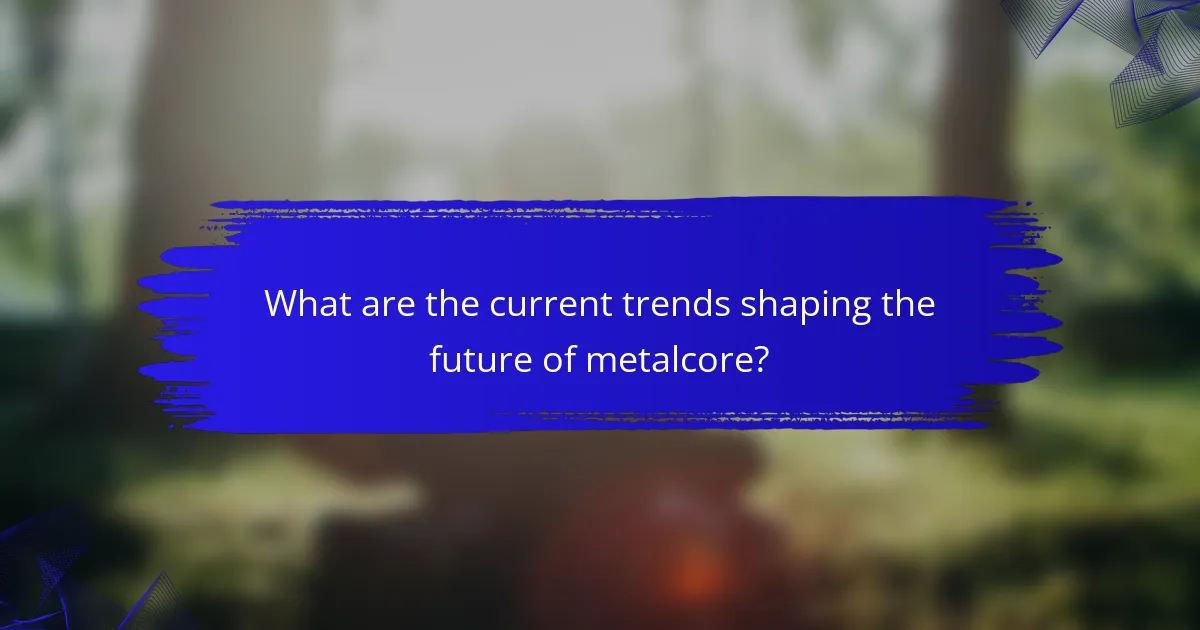
What are the current trends shaping the future of metalcore?
Metalcore is evolving through diverse influences, innovative sounds, and notable collaborations. Current trends include the integration of electronic elements, the rise of female-fronted bands, and genre-blending with pop and hip-hop. Essential tracks reflecting these trends feature complex rhythms, emotional lyrics, and powerful vocal performances. As a result, metalcore is becoming more accessible while retaining its core intensity.
How is technology impacting metalcore music production?
Technology significantly enhances metalcore music production by introducing advanced tools and techniques. Digital audio workstations allow for precise editing and manipulation of sound. The use of plugins and virtual instruments expands creative possibilities, enabling unique soundscapes. Additionally, online collaboration platforms facilitate remote contributions, broadening artistic input. As a result, metalcore continues to evolve, influenced by diverse genres through technology’s integration.
Which emerging bands are redefining the metalcore sound in 2025?
Several emerging bands are redefining the metalcore sound in 2025, including Spiritbox, Lorna Shore, and The Devil Wears Prada. These groups blend traditional metalcore elements with innovative influences, creating fresh sounds. Spiritbox combines ethereal vocals with heavy instrumentals, while Lorna Shore incorporates symphonic elements and deathcore influences. The Devil Wears Prada continues to evolve with their experimental approach, integrating diverse genres. Each of these bands showcases unique attributes that contribute to the ongoing evolution of metalcore.
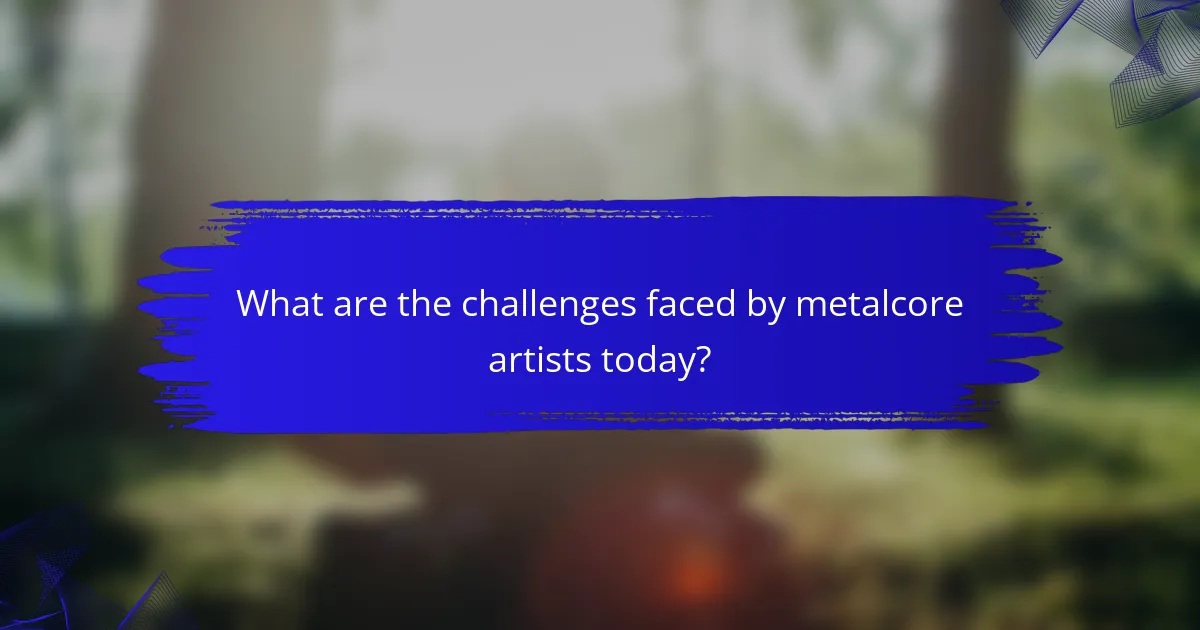
What are the challenges faced by metalcore artists today?
Metalcore artists face several challenges today, including genre saturation, evolving musical trends, and audience engagement. The rise of digital streaming has increased competition, making it harder for artists to stand out. Additionally, maintaining authenticity while adapting to commercial demands can strain creative expression. Financial instability due to fluctuating revenue streams further complicates their careers.
How do metalcore bands navigate the changing music industry landscape?
Metalcore bands adapt to the evolving music industry by embracing digital platforms and diverse influences. They leverage social media for promotion and fan engagement, enabling independent releases. Collaborations with artists from various genres expand their audience reach. Streaming services shape their distribution strategies, emphasizing the importance of playlists. The genre’s fusion with elements like electronic music and hip-hop reflects its unique attribute of versatility. As a result, metalcore remains relevant amidst changing listener preferences.
What common pitfalls should aspiring metalcore musicians avoid?
Aspiring metalcore musicians should avoid common pitfalls like lack of originality, neglecting vocal techniques, and poor stage presence. These mistakes can hinder their growth and audience connection.
1. Lack of Originality: Many musicians imitate popular bands instead of developing a unique sound, which can lead to being overlooked in a saturated market.
2. Neglecting Vocal Techniques: Failing to invest time in vocal training can limit a musician’s range and impact, affecting live performances.
3. Poor Stage Presence: A lack of engagement with the audience can result in missed opportunities for connection and support.
4. Ignoring the Importance of Collaboration: Working solo can restrict creativity; collaborating with others can bring fresh ideas and perspectives.
5. Overlooking Music Promotion: Not utilizing social media and other platforms for promotion can lead to limited exposure and growth.
6. Disregarding Feedback: Ignoring constructive criticism can prevent improvement and hinder artistic development.
What best practices can help metalcore bands succeed in the current market?
Metalcore bands can succeed by focusing on authenticity, engaging with their audience, and adapting to market trends. Building a strong online presence through social media and streaming platforms is essential. Collaborating with other artists can broaden their reach and introduce new influences. Regularly releasing quality content, including singles and videos, keeps fans engaged and attracts new listeners. Emphasizing live performances and connecting with local scenes enhances visibility and fosters community support.